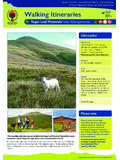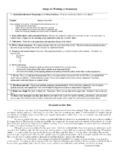Transcription of BATS, BUILDINGS AND DEVELOPMENT - Brecon …
1 Parc Cenedlaethol Bannau Brycheiniog Brecon Beacons National Park PLANNING ADVICE NOTE 17 (October 2008). BATS, BUILDINGS AND DEVELOPMENT . An advice note on how to ensure that bats are conserved during DEVELOPMENT affecting barns, other agricultural outbuildings and derelict or disused structures present and if so, how to This advice note does not relate to accommodate them within the dwelling houses. Where bats are DEVELOPMENT . found or known to roost within a dwelling house, you should contact 3. So that it is easier to provide this the Countryside Council for Wales advice, when you send in your (CCW) to seek appropriate advice. application form you should also provide photographs of the This advice note should not be used interior and exterior of the as a substitute for seeking expert building /part of building affected by advice from a licensed bat your DEVELOPMENT proposal.
2 The specialist. Whether or not a space photographs should include detail is occupied by bats can only be of roof structures (for example verified by such a specialist. roof covering, roof insulation if Bats and your planning visible, and timbers), entrances application (doors, windows, other openings). and proximity of trees, shrubs, ivy, 1. Bats roost in BUILDINGS because hedgerows etc. their natural roosts (tree holes, 4. This structural information will tree bark and caves) have become normally be sufficient for the more scarce or disturbed as a planning advisor to determine the result of human activities. All likelihood or not of bats being BUILDINGS in particular the walls, present. For example, a stone- wall cavities and crevices, attics, built barn with roof timbers and cellars, eaves, soffits, and roof an intact roof is likely to be used coverings are potential roost sites.
3 By some species of bat at some In addition some species may time during the year, whether for require space to fly within the roosting, feeding, resting or even building before departing to feed hibernating. each evening. 5. An ecological survey (see 2. Bats or bat roosts are a material Appendices 1 and 2) would consideration in determining report on what species of bat is planning applications. Therefore present, numbers of bats, entrance for all planning applications points and roost area(s). The affecting barns, other agricultural survey report would also provide outbuildings and derelict or recommendations for disused structures the planning accommodating the bats within advisor will advise that you may the DEVELOPMENT , for example need to commission an ecological how to maintain appropriate survey to find out if bats are entrance points, roost spaces, use of suitable materials to provide activities to conserve and learn the right environment, avoiding more about bats.
4 Disturbance by exterior lighting 11. Where bats have not been found, and the monitoring required after this advice note offers suggestions DEVELOPMENT is completed to on how you might design-in ensure that the mitigation has features to accommodate them been successful. (see Appendix 3. Planning 6. Where bats have been found, it Advice Note 18 is available for would be helpful to provide a copy accommodating barn owls within a of the report not only to the DEVELOPMENT .). planning advisor but also to the local offices of the Countryside Additional information Council for Wales (CCW). This will help to speed up the 12. In order to learn how you might consultation between the BBNPA know whether or not bats are and CCW. present, The Bat Conservation 7. Following receipt of the survey Trust provides an information report, planning conditions may leaflet on Bats and BUILDINGS in the control the DEVELOPMENT design, UK.
5 The Countryside Council for materials used, timetable of certain Wales (CCW) publishes "Bats in works, management of the site Roofs - A guide for building after DEVELOPMENT and monitoring professionals". the effectiveness of the works as 13. Contact details are provided they affect bats. below and further information is 8. Any works affecting bats can only provided in the appendices. be carried out under licence from Contact details The Welsh Assembly Government (WAG). So it again makes sense Countryside Council for Wales: to commission the ecological Cantref Court, Brecon Road, survey early in the planning Abergavenny NP7 7AX, process in order to increase your 01873 737 000. chances of complying with the WAG's conditions of the licence. Beechwood Office, Talu Road, The WAG will not issue the Llandeilo SA19 7HR, 01558 825. licence without first obtaining 800. evidence from the local planning Unit 4, Castleton Court, St.
6 Authority that bats, where present, Mellon's, Cardiff CF3 0LT, 02920. have formed a material planning 772400. consideration in determining your application. For information on bat conservation 9. The law still applies even where activities in your area: conditions are not attached to a planning permission. Local Bat Groups: 10. If you do have bats, it would be Brecknock Bat Group, Brecknock helpful if you were to inform your Wildlife Trust, Lion House, Bethel local bat group (see contact details Square, Brecon LD3 7AY. below), giving you the opportunity 01874 625 708. to become involved with local Carmarthen Bat Group - Neil Matthew, Countryside Council for Wales, Beechwood Office, Talu Road, Llandeilo SA19 7HR, 01558. 825 800. Gwent Bat Group - Ian Rabjohns, Millbank, Penallt, Monmouthshire NP25 4AJ, 01600 713 968. Glamorgan Bat Group - John Galvin, 32 Primrose Road, Pencaerau, Neath SA11 2AP, 01639 638 658.
7 For help with dealing with injured bats or bats in your living space, contact the Countryside Council for Wales or the Bat Helpline number: 0845 1300. 228 (local rate). For information on bat ecology, conservation and research: The Bat Conservation Trust, 15. Cloister House, 8 Battersea Park Road, London SW8 4BG, 0845 1300. 228, For information on wildlife in your area: The Biodiversity Information Service, 1st Floor Office, 7 Wheat Street, Brecon LD3 7DG, 01874 610 881, For further information on planning contact: Brecon Beacons National Park Authority Plas y Ffynnon, Cambrian Way, Brecon LD3. 7HP. Tel: (01874) 624437. Email: APPENDIX 1 Brecon BEACONS NATIONAL PARK AUTHORITY. BAT SURVEY - Suggestions for the minimum survey requirements for developments affecting bat roosts in barns, other agricultural BUILDINGS , disused or derelict structures. Note to bat surveyors: Following amendments to the Habitats Regulations (in the Conservation (Natural Habitats &c.))
8 (Amendment) Regulations 2007) and according to Bat Surveys: Good practice guidelines (Bat Conservation Trust 2007), it is best practice for surveys of potential roosts to be done by licensed surveyors. If a roost is discovered and might be or needs to be disturbed, the surveyor requires a licence issued by the Countryside Council for Wales to carry out the roost survey. On discovering a roost in a previously unknown location, an unlicensed bat worker must withdraw. On establishing that a roost is present in a structure, any works that have the potential to disturb this roost must be carried out under a separate Habitats Regulations licence (a DEVELOPMENT licence') issued by the Welsh Assembly Government, who will also impose their own conditions of licence. What to look for in a survey Summer surveys1 of all buildings2 affected by planning applications should ideally provide the following information about the use of the BUILDINGS by bats: Bat species present (different species occupy different spaces and have different internal micro-climate and flying space requirements (for example lesser horseshoe bats) which will influence final design).
9 Type and size of roost(s) (breeding/transition/hibernation; size of colonies . approximate numbers of bats per species). Precise location of roost(s). Precise location of roost access point(s). Periods during the year that are especially sensitive for the bat species present Activities to which the bats are especially sensitive Features and structures that are essential to the bat roost(s). Essential habitat features in the area surrounding the proposed DEVELOPMENT (landscape features to be retained and enhanced in order to provide cover and bat navigation routes to and from the roosts that are appropriate to the flight behaviour of each species present). A clear indication of whether or not the building (s) or other structures are [also]. likely to be used as a winter hibernation roost or other type of roost ( , mating roost, transition roost). The location of any winter hibernation roost within the building (s) or other structures 1.
10 It is possible that a building or BUILDINGS might also be used by different bat species as a winter hibernation roost, which would not be recorded during summer surveys. Therefore the survey results should also specify whether or not additional winter survey work (requiring different techniques) is required, giving the reasons why. 2. If works affect one or more mature trees, it is possible that bats might also roost within one or more of them, in which case additional survey and mitigation/compensation advice should be provided. APPENDIX 1 Brecon BEACONS NATIONAL PARK AUTHORITY. BAT SURVEY - Suggestions for the minimum survey requirements for developments affecting bat roosts in barns, other agricultural BUILDINGS , disused or derelict structures. Detailed information on how the proposed DEVELOPMENT would affect the bat roost(s) and clear, unambiguous recommendations on how to avoid this A clear indication of what additional survey work (if any) is required.








